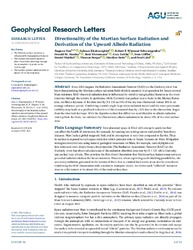Directionality of the Martian Surface Radiation and Derivation of the Upward Albedo Radiation
DOI: https://doi.org/10.1029/2021GL093912
Persistent URL: http://resolver.sub.uni-goettingen.de/purl?gldocs-11858/9745
Persistent URL: http://resolver.sub.uni-goettingen.de/purl?gldocs-11858/9745
Guo, Jingnan; Khaksarighiri, Salman; Wimmer‐Schweingruber, Robert F.; Hassler, Donald M.; Ehresmann, Bent; Zeitlin, Cary; Löffler, Sven; Matthiä, Daniel; Berger, Thomas; Reitz, Günther; Calef, Fred, 2021: Directionality of the Martian Surface Radiation and Derivation of the Upward Albedo Radiation. In: Geophysical Research Letters, Band 48, 15, DOI: 10.1029/2021GL093912.
 |
Dokument öffnen: |
Since 2012 August, the Radiation Assessment Detector (RAD) on the Curiosity rover has been characterizing the Martian surface radiation field which is essential in preparation for future crewed Mars missions. RAD observed radiation dose is influenced by variable topographical features as the rover traverses through the terrain. In particular, while Curiosity was parked near a butte in the Murray Buttes area, we find a decrease of the dose rate by (5 ± 1)% as 19% of the sky was obstructed, versus 10% in an average reference period. Combining a zenith‐angle‐dependent radiation model and the rover panoramic visibility map leads to a predicted reduction of the downward dose by ∼12% due to the obstruction, larger than the observed decrease. With the hypothesis that this difference is attributable to albedo radiation coming from the butte, we estimate the (flat‐terrain) albedo radiation to be about 19% of the total surface dose. Plain Language Summary:
Interplanetary space is filled with energetic particles that can affect the health of astronauts, for example, by causing late‐arising cancer and possibly hereditary diseases. Mars lacks a global magnetic field and its atmosphere is very thin compared to Earth's. Thus its surface is exposed to such space radiation which presents risks to future humans on Mars. Mitigation strategies could include using natural geological structures on Mars, for example, cave skylights and lava tubes and even simple buttes, for protection. The Radiation Assessment Detector (RAD) on the Curiosity rover has observed a decrease of the radiation absorbed dose rate by (5 ± 1)% while Curiosity was parked near a butte. This provides the first direct illustration that Mars's surface features may serve as potential radiation shelters for future missions. However, when exploiting such shielding possibilities, the secondary radiation generated in the terrain of Mars that is, emitted backwards must also be considered. Combining the RAD observation with a radiation transport model, we derive such “reflected” radiation dose on a flat terrain to be about 19% of the total surface dose. Key Points:
The Martian surface radiation is influenced by topographical features.
The surface downward radiation dose of particles traversing through the atmosphere depends on the zenith angle.
The surface upward radiation dose is about 19% of the total dose.
Statistik:
ZugriffsstatistikSammlung:
This is an open access article under the terms of the Creative Commons Attribution‐NonCommercial License, which permits use, distribution and reproduction in any medium, provided the original work is properly cited and is not used for commercial purposes.

